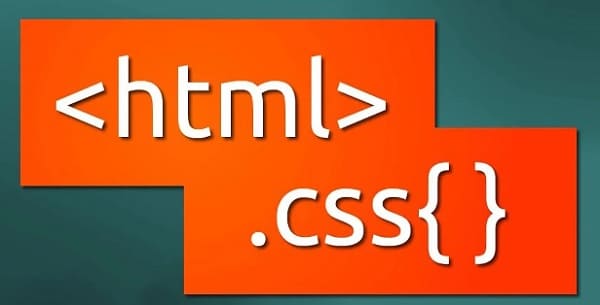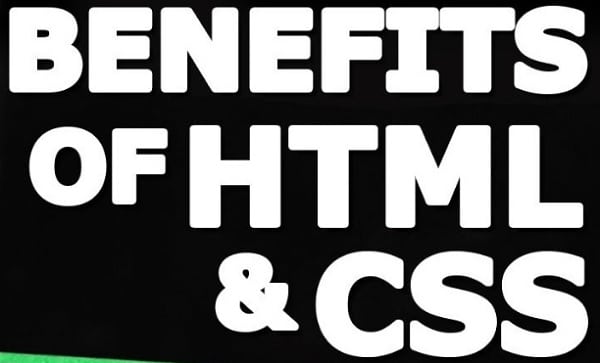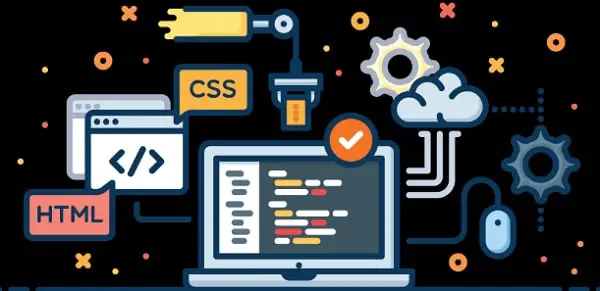Line25 is reader supported. At no cost to you a commission from sponsors may be earned when a purchase is made via links on the site. Learn more
If you’re a web designer or graphic designer, and you need to understand the basics of HTML, then stay here for just a few minutes to get a quick overview of this important coding language as well as CSS.
A significant section of the design community is still debating over the necessity to learn to code. Most designers think that web developers, web designers, and graphic designers should easily collaborate, but that’s not always the case.
I can imagine, because we are all human, some coders may see a designer who knows how to code to be a threat to the coder. A designer who has some basics of HTML and CSS should be regarded as a collaborator with some ability to speak the coding language.
Knowing a little coding doesn’t make a designer an expert coder, but only someone who understands the perspective of developers and is helpful with communication.
Usually, designers focus on aesthetics or UI design, but there is much more to HTML than just how the final project looks to the eye, and having this understanding makes both web and graphic designers a great asset to a multidisciplinary team.
HTML Basics Designers Should Know
Before we cover the basics, it’s important to take a look at what programming languages are first.
What is a Programming Language?

Coding or programming is like solving a puzzle. A programming language is a way to communicate with software. People that use these programming languages are called developers or programmers.
Programming languages tell the software about the structure and style of a webpage or how to move an object when users take a specific action.
While designing a webpage, the developers have to code every aspect of the website. They have to write instructions in a proper order to achieve the desired results.
After this, your web browser such as Safari, Chrome, Firefox, etc. converts these codes into something interactive so that it is easy to use. Without the browser, it is just a text file that only programmers can understand. So when you open a webpage, your browser loads all the programming languages involved and provides an interactive visual.
To create a website, graphic designers, web designers, and developers collaborate and decide the sections they will work on. If the designers know these programming languages, they can visualize the idea of the website better. Along with this, they can help the developer achieve their visuals perfectly.
CSS and HTML are not technically programming languages. They are just style and structure information about the webpage. HTML and CSS are on the front end of each application and web page.
Acquiring some foundational knowledge of the front end, which CSS and HTML drive, would greatly benefit designers. HTML stands for the hypertext markup language, and CSS stands for cascading style sheets (a language that describes the component styles in an HTML document).
Designers would be shocked to see how easy it is to learn the basics of CSS and HTML. Both languages are not based on programming logic. HTML describes the structure of pages on a website and is the building block of pages. HTML with JavaScript and CSS form the foundation of technologies for the World Wide Web.
In simple words, HTML tells the website what to display, and CSS tells it how to display the website. CSS is a simple code structure that determines colors, position, typography, and dimensions.
HTML – Hyper Text Markup Language

HTML is the main building block of designing a website. HTML is a basic language and only requires memorizing some HTML commands to build the structure of your webpage. It consists of a series of elements that you use to make the content appear in a certain way.
The enclosing tags can make words bold, italic or make them smaller or bigger. So, it’s better to draw out the ideas, to help you visualize the look of your site. It is also a good idea to decide how you will store your files, whether all of them will be in the same directory or not.
Additionally, you should consider whether you will save the file as .htm or .html file. Also, consider if you want to have the same template for all your web pages or not.
Markup languages label the content types using specific code, especially HTML tags. These tags include paragraph tags, header tags, image tags, and so on. A webpage is made up of these tags that denote each type of content on the webpage.
HTML tags surround each type of content. To take an example – if you wish to write this article in HTML, you will start with <p>, which denotes the opening of the paragraph instead of some other content. Once a tag is opened, the content after the tag is assumed to the part of the tag until your write </p> to denote that you want to close the paragraph.
The difference between the opening and closing tag is a forward slash that only appears when you close a tag.
<p> Paragraph content</p>
By using HTML, you can insert images, control some styling, format paragraphs, make lists, create special characters, add headings, create links, control line breaks, build tables, emphasize text, and much more.
CSS – Cascading Style Sheets

CSS is a programming language that controls the HTML elements of the website and determines the appearance of the page. CSS allows designers to make changes on their webpages like adding a full-screen hero image, centering a webpage in the display window, fonts used in the website and using a pseudo selector for designing interactive content like forms and links.
It also helps in adjusting the space between HTML elements with padding and margins. With CSS, you visualize how padding, borders and margins affect the height and width of a component. Once you make a change to your website’s CSS style sheet, it is possible to make a change on every page automatically.
Making changes using CSS is easier when your website is significant. Additionally, CSS not only saves time but also makes your website style look consistent.
CSS separates the website content from its design language. This reduces your file transfer size. The CSS document is stored externally and can be accessed when a user requests your website. In contrast, when you use tables, every page on the site will be accessed on each visit.
Reduction of bandwidth will mean that the website will load faster and also cut your web hosting costs. CSS is a clean coding technique, so search engines don’t have to struggle to read the content of the website.
Additionally, CSS will reduce code and instead increase content which is critical for a search engine to identify your website. Since the introduction of Google Chrome, users have had more browsers than ever which makes browser compatibility a massive problem for sites. CSS style sheets increase a website’s adaptability and make sure that more users can view your website the way you intended.
Another major issue solved by CSS is the website’s compatibility with different media. CSS allows you to create the same markup page that can be presented in different viewing styles. For example, you can make a separate style sheet for a mobile device or print using CSS.
With so many advantages, CSS is a smart choice for web and graphic designers.
Importance of using HTML and CSS together

HTML offers raw tools required to structure the content on the website. On the other hand, CSS helps to style the content, so that it appears in the desired way. Both these languages are kept separate so that the website is appropriately built before they are reformatted.
So HTML may be the basic structure of your website, but CSS gives style to your entire site. All those new fonts, slick colors and background images are determined by CSS. This language determines the mood and tone of the website, making it an essential tool for web developers. CSS also allows the website to fit in different display sizes and device types.
In simple words, CSS assigns properties to HTML tag whether it is multiple tags, single tag, entire documents or multiple documents. It exists because colors and fonts were developed. Web designers had to struggle a lot to adapt HTML to these new features.
In 1990 HTML was not developed to show physical formatting information. It was meant only to define the structure of a document. HTML outgrew all design features and CSS was released and invented in 1996. All formatting was then removed from HTML document and stored in a separate file as .css.
Every web browser has a default style sheet, so when you go to a web page, every page has at least one style sheet that affects it. The default style sheet depends on what the visitor is using.
For example, if a website does not have a style sheet, the visitor will see the default style sheet that is set for his browser. However, if the web developer has established a style sheet for its website, the website will not show the default style sheet.
This is where the word cascading of CSS comes in play. The last defined stylish sheet will inform the visitor’s browser what instructions have precedence.
Benefits of knowing HTML and CSS

Learning to code the UI (user interface) and previewing it offers designers the opportunity to see how things will look when viewed on different devices.
Working More Efficiently
If designers have some understanding of HTML and CSS, they will see how everything is measured in pixels (other measurements like percentages and “ems” will be converted to pixels).
Also, understanding code structure and sizes, i.e., how pages will be displayed, this will give a better understanding of the front-end development process allowing the designer to think practically about their designs and how to make the process more efficient.
Another efficient benefit to understanding these languages, the designer won’t have to run to the developer to solve small issues, causing developers to be more eager to work with you.
So whether you are a freelancer or work in a design company, not knowing programming languages will ultimately limit you and make you less efficient.
Better Communication
Another benefit of understanding the language of developers is being able to read their minds, so to speak. If designers and developers can speak each other’s language, it will be elementary for them to collaborate and design a website.
Understanding the thought process of developers and what their requirements are to complete their job successfully will make designers a great asset to the company. This approach is useful for idea pitches as well as internal communications. If designers start understanding HTML and CSS, they will be in a better position to propose a compelling plan to clients.
More Employment Opportunities
Apart from the usual advantages, job opportunities increase if you know how to code as it makes day to day work and screening processes easy.
Recruiters of design-based companies are always attracted to hybrid profiles. Especially startup companies are eager to find candidates that can handle work in both the front-end and design fields.
Some developers and designers are, however, threatened to see people with both skills. But the truth is every individual should analyze their options while focusing on what increases their chances of having a successful career.
Designers need not know everything about coding, but the basics of HTML and CSS can add significant distinction to your profile. Learning the basics should be easy for designers. The more designers know, the more they can explore different job opportunities.
There are many reasons web designers and graphic designers should learn to code, but one very important reason for having basic knowledge of HTML and CSS is to be one step ahead of the competition as well as receive positive favor from employers.
Improve Creativity
Along with understanding the practical use of your designs, knowing how to code also allows you to enhance your creativity. You will be able to sketch your designs in Sketch or Photoshop and then execute your plans the way you imagined them.
Final Thoughts
In conclusion, some believe that people who focus on a particular skill are stronger professionals. On the other hand, some people believe that a multi-skilled web or graphic designer has a big advantage over their peers and other freelancers who are non-coders.
At the end of the day, nothing should stop the designer who wants to acquire another skill like coding or just understanding the basics of HTML.

